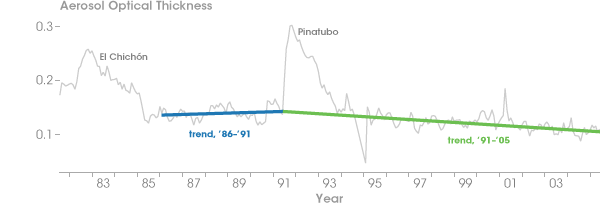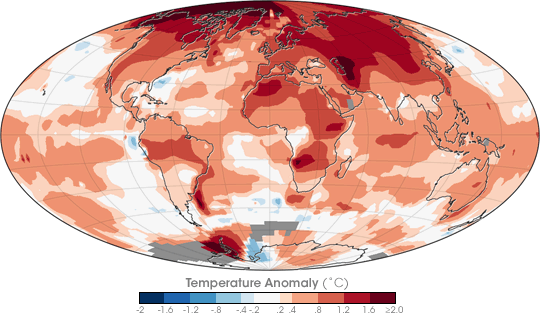

From A Dimmer Past to a Brighter Future? | |||
Of greater concern to Hansen than global warming skeptics is the problem of global warming itself. If greenhouse gases are to blame then why did Earth’s average temperature cool from 1940-1970? And why has the rate of global warming accelerated since 1978? Hansen’s answers to these questions brought him full circle to where he began his investigation more than 40 years ago. “I think the cooling that Earth experienced through the middle of the twentieth century was due in part to natural variability,” he said. “But there’s another factor made by humans which probably contributed, and could even be the dominant cause: aerosols.” |
|||
 | |||
In addition to greenhouse gas emissions, human emissions of particulate matter are another significant influence on global temperature. But whereas greenhouse gases force the climate system in the warming direction, aerosols force the system in the cooling direction because the airborne particles scatter and absorb incoming sunlight. “Both greenhouse gases and aerosols are created by burning fossil fuels,” Hansen said, “but the aerosol effect is complicated because aerosols are distributed inhomogeneously [unevenly] while greenhouse gases are almost uniformly spaced. So you can measure greenhouse gas abundance at one place, but aerosols require measurements at many places to understand their abundance.” After World War II, the industrial economies of Europe and the United States were revving up to a level of productivity the world had never seen before. To power this large-scale expansion of industry, Europeans and Americans burned an enormous quantity of fossil fuels (coal, oil, and natural gas). In addition to carbon dioxide, burning fossil fuel produces particulate matter—including soot and light-colored sulfate aerosols. Hansen suspects the relatively sudden, massive output of aerosols from industries and power plants contributed to the global cooling trend from 1940-1970. |
Pollution from factories, cars, airplanes, home furnaces, and power plants form aerosols—tiny particles suspended in the air. These particles reflect and absorb sunlight, slightly cooling the Earth’s surface. (Photograph ©2007 Señor Codo.) | ||

“That’s my suggestion, though it’s still not proven,” he said. “There is a nice record of sulfates in Greenland ice cores that shows this type of particle was peaking in the atmosphere around 1970. And then the ice core record shows a rapid decline in sulfates, right about the time nations began regulating their emission.” (Sulfates cause acid rain and other health and environmental problems.) In 2007, Michael Mischenko, of NASA GISS, published a paper in the journal Science in which he reported tropospheric aerosols have indeed declined slightly over the last 30 years. The net effect is that more sunlight passes through the atmosphere, slightly brightening the surface. This increased exposure to sunlight could partially account for the increase in surface temperature that Mischenko and Hansen observed over the same time span. |
Sulfur trapped in the Greenland Ice Sheet records the presence of reflective sulfate aerosols downwind of the United States and Canada. Emissions of the pollutants that form sulfate aerosols rose sharply in the United States and Europe during and after World War II. This rise may be responsible for the Northern Hemisphere cooling from 1940–1970. By the 1980s, oil embargos and environmental controls had reduced sulfate pollution in North America, but carbon dioxide continued to build up in the atmosphere. (Graph by Robert Simmon, based on data from McConnell et al., NOAA/NCDC Paleoclimatology Program.) | ||
 | |||
Over the course of the twentieth century, Hansen and other climate scientists estimate aerosols may have offset global warming by as much as 50 percent by reducing the amount of sunlight reaching the surface. Scientists call this phenomenon “global dimming,” although the change was too gradual and too slight to be perceived by the human eye. (Aerosols’ dimming potential has been observed, of course, after dramatic events like the Agung Volcano eruption that Hansen noticed during the lunar eclipse of December 1963.) Hansen describes the global dimming effect of human-emitted aerosols as a “Faustian bargain”—a deal with the devil. “Eventually you get to a point where you don’t want aerosols in the atmosphere because they’re harmful to human health, harmful to agriculture, and harmful to natural resources,” he stated. “So in the U.S. and much of Europe, we’ve been reducing aerosol emissions.” But we haven’t seen a corresponding reduction in greenhouse gas emissions. Indeed, humans’ use of fossil fuels rose rapidly (about 5 percent per year) from the period after World War II until 1973. After the oil embargo and price shock of oil in 1973, annual average consumption continued to increase, but at a slower pace (between 1.5 and 2 percent per year). A byproduct of that rising fossil fuel consumption has been a corresponding rise in carbon dioxide emission. Because greenhouse gases reside in the atmosphere for decades, while aerosols usually wash out over a span of days to weeks, the warming influence of greenhouse gases gradually won out. “For much of the twentieth century, both types of human emissions were on nearly equal footing, and aerosols were able to compete with greenhouse gases,” Hansen said. But that balance has tilted increasingly in favor of greenhouse gases in the last 30 years. Today, Hansen’s team estimates the human forcing from greenhouse gases to be about 3 watts per square meter (warming) and the forcing from aerosols to be about minus 1.5 watts per square meter (cooling). Hansen sees these trends as very likely to lead to what he calls “dangerous human interference” with the climate system. “I think action [to reduce greenhouse gas emissions] is needed urgently, because we are on the precipice of a climate system ‘tipping point’,” Hansen concluded. “I believe the evidence shows with reasonable clarity that the level of additional global warming that would put us into dangerous territory is at most 1°C.” |
Satellite observations of aerosol optical thickness (how greatly aerosols reduce the intensity of sunlight reaching the surface) show that aerosol concentrations have decreased since 1991 (green line). Prior to that, they had been rising slightly (blue line). In addition to the long-term trends of human-made aerosols, the graph shows the occurrence of large volcanic eruptions like El Chichón in 1982 and Mount Pinatubo in 1991. These natural events produce large spikes in aerosol concentrations, but their impact is short-lived. (Graph adapted from Mishchenko et al., 2007) | ||
 | |||
If we follow a ‘business-as-usual’ course, Hansen predicts, then at the end of the twenty-first century we will find a planet that is 2-3°C warmer than today, which is a temperature Earth hasn’t experienced since the middle Pliocene Epoch about three million years ago, when sea level was roughly 25 meters higher than it is today. [Editor’s Note:Editor's note: The NASA GISS Surface Temperature Analysis site contains additional discussion, sample maps and graphs, and links to the programs used by Hansen’s team to process the surface temperature data.]
|
This map shows the difference in surface temperature in 2006 compared to the average from 1951 to 1980. Most of the globe is anomalously warm, with the greatest temperature increases in the Arctic Ocean, Antarctic Peninsula, and central Asia. NASA’s effort to track temperature changes will help societies evaluate the consequences of global climate change. (Map based on data from NASA GISS Surface Temperature Analysis.) | ||